Magento Vs BigCommerce — Which Is Better for Business?

Choosing between eCommerce platforms is anyway challenging, but the task gets doubled when you have platforms like Magento and BigCommerce standing against each other.
If it was just a matter of popularity, Magento would have easily won. Yes, according to a BuiltWith report, there are three times more Magento stores than BigCommerce.

Fortunately, the decision is dependent on facts too. And the facts say, both Magento and BigCommerce have a huge market share. They offer great features to kickstart your eCommerce journey and support interactive shopping.
But there’s more to each one that makes retailers favor one over the other. To help you decide better, I’ve researched, tested, and thoroughly examined both platforms to provide a comprehensive review.
If you want a platform that is easy to use, flexible to design, is budget-friendly, and provides great support, keep reading to find the best platform for you.
But first, let’s quickly introduce the two big eCommerce platforms.
Magento Vs BigCommerce — Understanding the Platforms
No one likes to read through longer explanations. So, in this section, we’ll gain a brief overview of both platforms.
Magento Overview
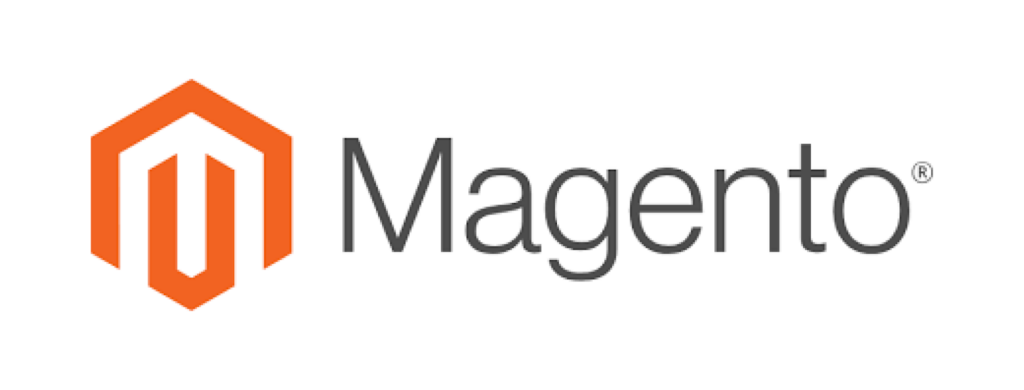
Magento (now Adobe Commerce) is a leading eCommerce platform known for its flexibility and scalability. It is an open-source platform, launched in 2008, which was recognized as a leader in the 2022 Gartner Magic Quadrant. The platform caters primarily to medium to large-sized B2B and B2C businesses.
Magento’s strength lies in its deep customization options, allowing businesses to create unique online shopping experiences. While coding expertise can help obtain its full potential, the platform also offers user-friendly tools for merchants without extensive technical backgrounds with its paid editions.
Also, it comes with strong SEO and marketing features that help businesses drive growth and customer engagement.
BigCommerce Overview

BigCommerce is a leading Open-SaaS eCommerce platform with exceptional flexibility and comes with a robust feature set. The platform is Ideal for companies generating less than $50 million in annual revenue. With nearly 50,000 active online stores, BigCommerce is quite popular as well.
The platform comes with subscription fees starting at around $29 per month, which is excellent and convenient for small to medium-sized businesses. Unlike many competitors, BigCommerce comes packed with built-in features, eliminating the need for costly third-party integrations.
Many of the high-profile businesses like Toyota, Kodak, and Ben & Jerry’s rely on BigCommerce to manage their online stores. The platform is great at multi-channel selling, making it easy to reach customers across various platforms, including social media.
Excited to learn more after reading our quick overview? I assume, Yes.
Let’s quickly get ahead to the comparison of these platforms based on multiple aspects.
Magento Vs. BigCommerce — How They Stack Up Against Each Other?
Before we begin to discuss each aspect in detail, I’ve shared a table highlighting the differences between Magento and BigCommerce. Please take a glance before moving ahead.
| Aspect | Magento | BigCommerce |
| Date Of Release | 2008 | 2009 |
| Web Hosting | Both, on-premise and cloud-based | Cloud-based |
| User-Friendliness | Bit Complex | Easy |
| Features | Feature-packed | Feature-packed |
| Extensions | Over 4000 | Over 1000 |
| Integration Capability | Flexible | Flexible |
| Themes | 17 official themes, tons of unofficial ones, and can be custom-designed | Over 50 paid and 7 free themes |
| Multi-language Capacity | Has the built-in multi-language feature | Need third-party support for multi-language features |
| Payment Methods | 3 built-in payment gateways with a scope to add more via API | Supports 40 payment gateways |
| Security Standards | PCI compliant with advanced support | PCI compliant with available free and paid SSL certification |
| Supported Devices | iPhone/iPad, Windows, Android, Mac, Web-Based | iPhone/iPad, Windows, Android, Mac, Web-Based |
| Support | Fora(official documentation), 24*7 support for Adobe Commerce | 24*7 chat, email, and phone support |
| Pricing | – Open Source: Free– Commerce: $22,000/year– Commerce Cloud: $44,000/year | – Standard: $29/month– Plus: $79/month– Pro: $199/month– Enterprise: quote-based |
| Ideal Business Size | Medium to Large | Small to Medium |
Now, join me for an in-depth explanation and see how Magento vs BigCommerce stacks up against each other based on popularity, user-friendliness, pricing, eCommerce functionalities, and more.
1. Popularity

The popularity of an eCommerce platform shows how capable and reliable it is. Magento and BigCommerce are both top choices, but there’s a noticeable difference in their user numbers.
As we saw earlier, Magento is a more popular eCommerce platform when considering the number of live websites. Data from BuiltWith shows that there are currently 1,27,656 live websites using Magento, which includes over the top 10,000 websites worldwide. Magento’s user base includes larger and more recognizable names such as Nike, Coca-Cola, and Christian Louboutin.
On the other hand, BigCommerce hosts 43,097 websites worldwide. Despite having a smaller presence compared to Magento, the platform is trusted by top brands like Sony, Skullcandy, Toyota, and Ford.
However, the data suggests that Magento is a preferred choice for well-established brands with larger businesses.
2. Ease Of Use
As a store owner, you’ve multiple tasks to work on from branding to testing new products. In the middle of managing all of those tasks, you cannot afford to get stuck with a complex eCommerce platform that requires a big chunk of your time to manage your daily tasks in-store.
A simple, user-friendly backend helps you get tasks done quickly so you can focus on what matters most.
Setting up a new store on Magento requires some development skills. If you’re a non-technical person, making changes like theme modifications, extension integrations, speed optimizations, and more, can be challenging with Magento as it often revolves around code.
Here’s a glimpse of its dashboard.

This requires many store owners to rely on Magento experts for development and maintenance.
However, once the initial setup is complete, Magento’s backend is quite user-friendly. You can easily customize features, add products, create customer groups, set up currencies, and more without any hassle. Lastly, Magento users need to find and manage their own hosting solutions, which can add to the required time and effort.
BigCommerce is an easy solution when compared to Magento. The platform provides a clean user interface for its dashboard and allows creating a store with its drag-and-drop page builder without needing to custom code. So, Once on the dashboard, you can easily manage everything—import products, tweak layouts, or name it.
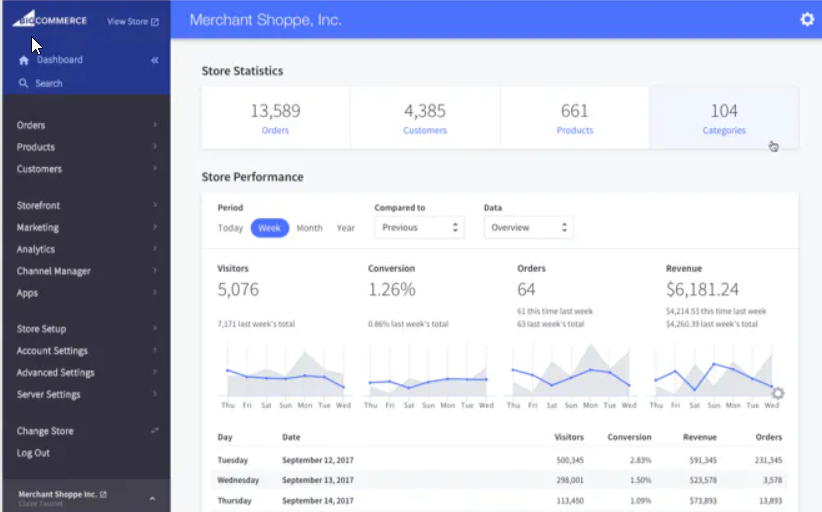
BigCommerce comes with a drag-and-drop page builder that helps you build, design, and customize your store functionalities without ever needing custom code. All you have to do is drag and drop needed elements onto the canvas and you’re done.
Here’s a glimpse of its drag-and-drop page builder.
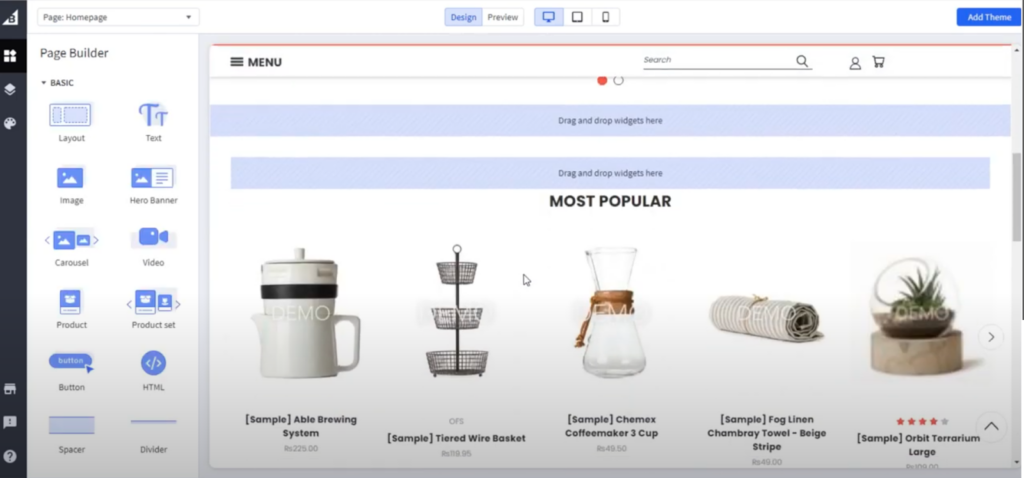
On top of that, BigCommerce’s pricing plans cover cloud-based hosting, so, all you have to focus on is your business tasks.
In short, both BigCommerce and Magento offer user-friendly management in their unique ways. While Magento requires coding for setup and customization, BigCommerce may not require technical skills.
3. Pricing
Pricing is crucial when choosing an eCommerce platform because it directly impacts your budget and profitability. The right pricing plan ensures you get the needed features without overspending.
Let’s compare Magento and BigCommerce pricing details to find out which platform helps you scale efficiently without hurting your pockets.
Magento Pricing
Regarding pricing, Magento has two main options: the free version and the paid version.
Magento Open Source is free and perfect for small businesses or developers. You can download it, but you’ll need to handle hosting and add extra features through plugins, which can add up around $4,000 to $5,000.
On the other hand, Magento Commerce (now Adobe Commerce) is a premium, hosted solution. It’s designed for big businesses with high-volume stores, costing over $10,000 a year. It includes cloud hosting, advanced features, and dedicated support from Adobe.

In short, costs vary widely depending on your needs, from a few bucks a month to thousands annually.
BigCommerce Pricing

BigCommerce offers three main pricing plans with one enterprise-level pricing plan where they provide a subscription fee after discussing requirements with merchants.
| Pricing Plans | Pricing | Best For |
| Standard | $29 | Small businesses |
| Plus | $79 | Medium-sized businesses |
| Pro | $299 | Medium to large-sized businesses |
| Enterprise | Quote-based | Enterprise level businesses |
When it comes to enhancing your BigCommerce store, you’ve got options to fit every need and budget.
For themes, if you’re looking at official BigCommerce themes with high-quality design elements and seamless integration, expect to invest between $195 and $300. However, if you’re open to other options, Themeforest offers a wide range of themes priced between $60 and $200. These are great options when you want something out-of-the-box and unique.
For Plugins, BigCommerce’s app store has you covered with various options, ranging from $9 to $90 per month. These plugins help you create a more dynamic shopping experience.
4. Features & Functionality
When selling online, a built-in set of available features provides a seamless buying experience. This enhances customer satisfaction and eliminates the need for additional plugins, saving time and money to eCommerce store owners.
Here we’ll discuss a comprehensive comparison of the built-in features offered by Magento and BigCommerce. Let’s see which platform can deliver more benefits for your business.
| Magento Features | BigCommerce Features |
| Marketing, Promotions, And Conversion Tool | Drag-And-Drop Website Builder |
| Site Management | Product Catalog |
| Catalog Management | Marketing Tools |
| Search Engine Optimization | Payment And Inventory Management |
| Product Browsing | Seo And Analytics Optimization |
| Catalog Browsing | Products And Merchandising |
| Order Management | Social Media Marketing |
| Checkout, Payment, And Shipping | Product Options And Bundling |
| Customer Accounts | In-Store Search |
| International Support | Multi-Currency Support |
| Mobile Commerce | Mobile-Optimized Store |
| Customer Service | Configurable Fields |
| Analytics And Reporting | Social And Cross-Channel Commerce Integration (Amazon, Ebay, Etc) |
| Abandoned Cart Recovery | Google Amp On Product And Category Pages |
| Customer Segmentation | |
| Tax Calculation |
Okay, so that was a general overview of features offered by both of the platforms.
And we saw that both Magento and BigCommerce stand out for their remarkable capabilities. Magento comes with multi-store management features and offers robust tools for on-site promotions, making it a strong contender for complex and diverse retail needs.
On the other hand, BigCommerce shines with its seamless integration capabilities, simplifying the connection with various sales channels and payment gateways.
In the end, it’s a tight race between the two, and it’s safe to say that both platforms bring unique strengths to the table.
5. Themes & Extensions
Themes and extensions are a crucial part of an online store.
This makes it necessary for you to choose a platform that supports a wide range of templates and plugins, helping you build a unique store. So, let’s check if Magento or BigCommerce is better with themes and extensions. Also, we’ve separated the discussion for themes and extensions; starting with comparing themes.
Themes
In just 50 milliseconds, visitors can form an opinion about your website. That’s why having a fast, mobile-friendly, and visually appealing design is crucial. But can Magento and BigCommerce deliver on these expectations?
Regarding design options, Magento provides only 17 themes, with just one available for free. The remaining themes are priced between $30 and $499, offering a variety of styles but at a cost.
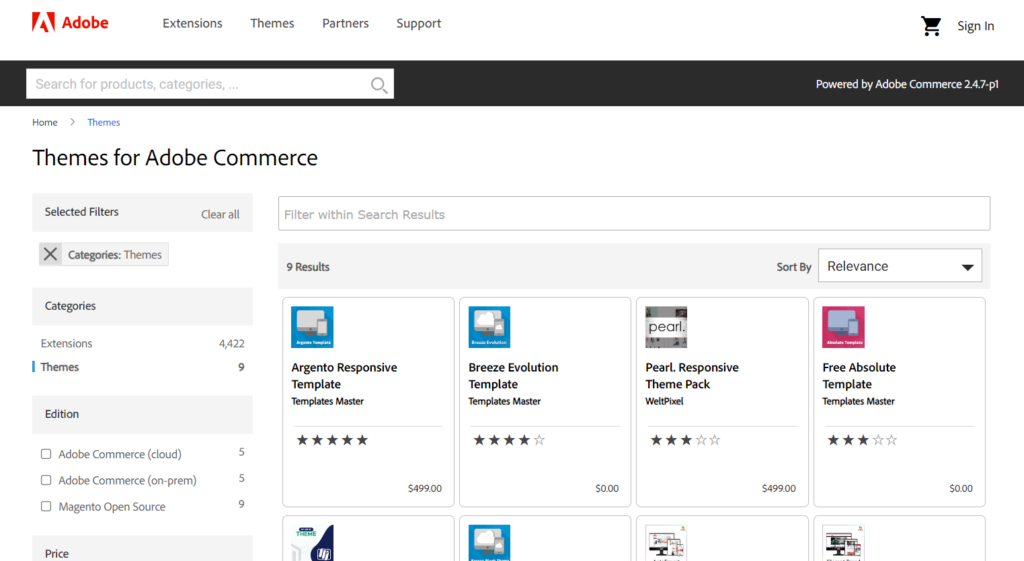
If you’re up for a challenge and have some coding skills, you can try creating your own theme. However, be prepared to invest significant time. Honestly, it would be best for you to consider custom hiring a professional—costs can start around $5,000.
Magento offers unparalleled customization options compared to BigCommerce. However, this flexibility requires more time and effort to get everything just right. Magento’s theme library, complemented by thousands of extensions, provides endless possibilities to enhance your store’s look and functionality.
Also, you’ll find multiple Magento-compatible themes on Themeforest and from third-party providers.
On the other hand, BigCommerce offers a more straightforward approach with seven free themes and over 50 paid options priced between $145 and $235. These themes are mobile-friendly and come equipped with industry-specific features, making them a great choice for businesses looking for a quicker, more streamlined setup.

You can easily filter them by catalog size, AMP compatibility, or industry to find the perfect fit.
While customizing BigCommerce templates might not be as straightforward as with some other platforms, it’s still pretty simple to get started.
You can add products with ease and use the “Product Set” widget to display them beautifully, helping visitors compare and explore your catalog.
Extensions
Native functionality can sometimes be insufficient. In such a scenario, you need extra add-ons and apps to extend a helping hand. Let’s check how Magento and BigCommerce support extension integration.
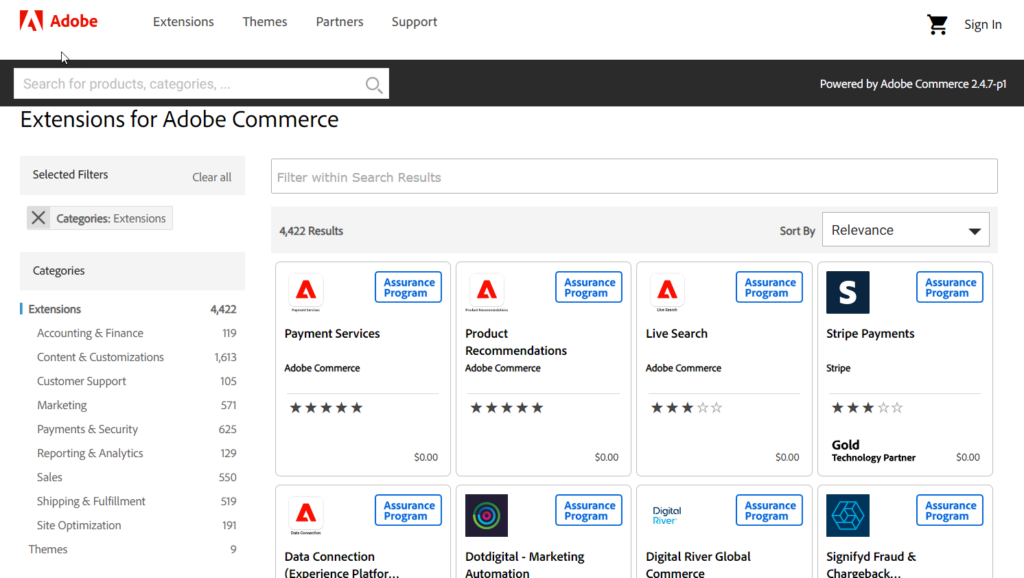
Magento offers a robust suite of built-in features, including integrated checkout, payment processing, shipping solutions, and comprehensive catalog management. Beyond these native capabilities, Magento extends its functionality through an extensive library of over 5,000 third-party extensions.
These feature-rich extensions can be seamlessly integrated into the Magento backend. They are designed to enhance various aspects of your online store, like boosting sales, refining customer experience, and optimizing overall performance.

BigCommerce, on the other hand, also offers over 1000 extensions within its app store, allowing store owners to expand their capabilities and further improve their online presence. You can easily download them from your store’s admin panel.
6. Performance & Scalability

Slow loading times can frustrate customers and lead to lost sales. Also, factors such as product quantity, image size, caching, and hosting infrastructure significantly impact performance. So let’s check which platform helps better with these areas to bring in better load times.
When it comes to performance optimization, Magento offers great flexibility.
First of all, your Magento store’s performance will depend on your chosen hosting, server settings, and CDN. You can easily achieve exceptional load times once you’ve got them in the right amount. Magento also supports Progressive Web Apps (PWA), which further enhances speed and performance.
On the other hand, BigCommerce comes with its hosting environment which simplifies performance management for merchants. The platform’s integration with Google AMP (Accelerated Mobile Pages) helps ensure faster mobile experiences, which holds higher value for improving user experience.
Additionally, BigCommerce offers built-in image optimization tools to reduce load times.
While BigCommerce offers strong performance and user-friendly management, its scalability may be challenged when dealing with extensive product catalogs or sudden traffic surges.
On the flip side, Magento provides exceptional scalability to handle large product assortments and high traffic volumes. However, achieving optimal performance with Magento requires technical proficiency and ongoing optimization.
7. Security
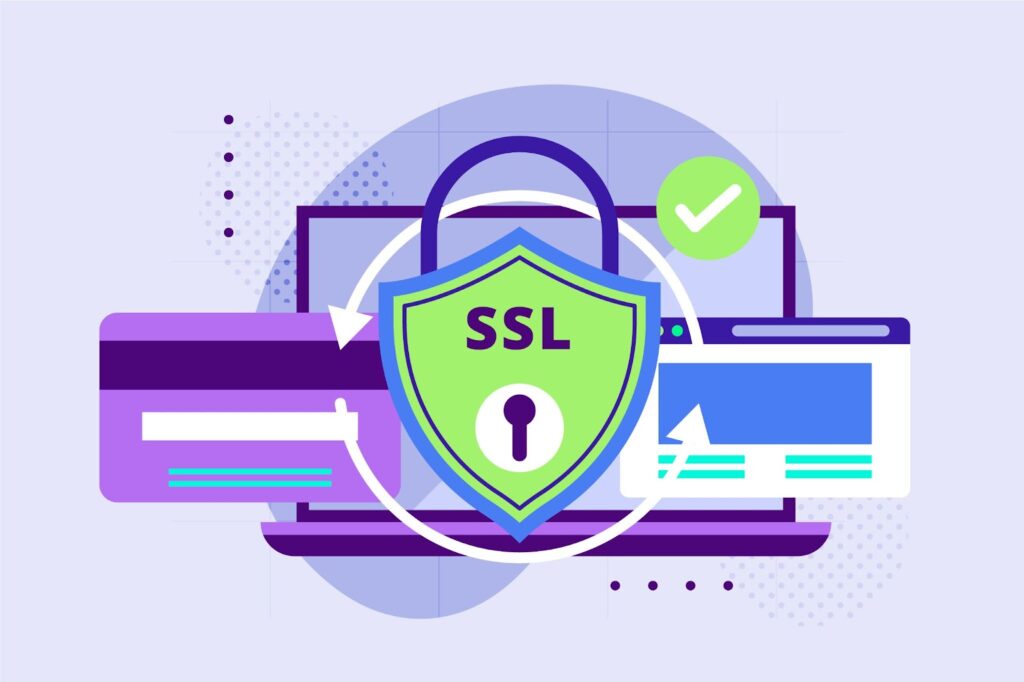
One significant concern with eCommerce is the risk of security breaches. To protect your customers’ sensitive information, you must choose a platform that’s PCI-compliant and equipped with robust security measures.
BigCommerce stands out as a secure option, being both Level 1 PCI and ISO/IEC 27001 certified. This ensures that all financial transactions are encrypted and protected, giving you and your customers peace of mind.
Additionally, BigCommerce offers both free and paid SSL certificates with all their plans, providing an extra layer of security. The platform also features multiple security layers to prevent unauthorized access, making it a comprehensive choice for your online store’s safety.
Adobe Commerce is another top contender for eCommerce security. It is PCI compliant and utilizes advanced technologies like Zend Framework, Composer, PHP 7, and Symfony to safeguard your store.
The platform also supports SSL certificate integration, further enhancing your site’s security. For those seeking even more protection, Adobe Commerce allows merchants to add Magento 2 security extensions. Moreover, the platform regularly updates with security patches to protect against malware and cyberattacks.
Both BigCommerce and Adobe Commerce offer strong security features to protect your eCommerce business, but the best choice depends on your specific needs and preferences.
8. Customization Capabilities

A website that aligns perfectly with a brand’s unique identity can significantly enhance the customer experience and create a lasting impression on users.
But which platform offers the best customization capabilities and helps you achieve them?
Magento truly stands out in this regard. Known for its limitless flexibility, Magento is the go-to platform for large enterprises that desire complete control over their website’s look and feel.
Unlike other platforms that may depend heavily on third-party apps, Magento allows businesses to tailor their sites precisely to their needs, ensuring a seamless and branded customer experience.
There are several effective customization approaches while using Magento:
- Pre-built Themes — Magento offers a variety of pre-built themes, both free and paid. You can choose the one that best aligns with your brand and easily make modifications to suit your needs.
- Third-party Extensions — With over 4000 extensions available in the Magento marketplace, you can find tools like that simplify theme customization. These extensions empower developers to tailor the Magento experience to meet specific requirements.
- Code Modifications — For businesses with complex needs, code modifications provide the most advanced level of customization. This approach allows for changes that are beyond the capabilities of third-party extensions. However, it requires the expertise of a skilled developer to implement these modifications successfully.
In contrast, BigCommerce operates as a SaaS (Software as a Service) platform, restricting backend access. While you can make some adjustments to frontend elements like store themes using JavaScript, many customizations that require backend modifications were limited.
This used to demand extensive alterations. However, over the years BigCommerce has introduced features and capabilities to address some of the customization limitations.
And yes, Magento stands out as the clear winner, especially for large enterprises. This platform allows businesses to create highly personalized experiences for their customers.
9. Time To Market

The speed at which a company can introduce its products or services is crucial in today’s rapidly evolving business landscape. To stay ahead, businesses must prioritize a swift and efficient market entry. This is where Time to Market (TTM) becomes a critical factor.
With Magento, expect at least a month to get your site up and running due to the development phase. Here is why –
- Complex Setup — Installing and configuring Magento involves several intricate steps. From setting up your domain and hosting to integrating extensions, each phase demands careful attention, making the setup process time-consuming.
- Extensive Customization — Magento is often the go-to choice for businesses needing sophisticated customization. While this flexibility is a significant advantage, it also means that development time can be longer to tailor the platform to your specific needs.
- Technical Expertise Required — Magento’s robust capabilities require a certain level of technical know-how. Most merchants are not developers, so finding a skilled Magento developer is crucial for an efficient setup and smooth operation. This can add to the overall time and cost of launching your store.
BigCommerce, on the other hand, allows you to launch within a week. You can drag and drop your storefront, import products, set up payment options, and handle everything else quickly and easily.
- Easy Setup — BigCommerce is designed for beginners, making it incredibly simple to set up your online store without needing any coding skills. Its user-friendly interface ensures that you can get your shop up and running in no time.
- Pre-built Themes and Apps — With several pre-built themes and apps available, BigCommerce allows you to choose a theme that best aligns with your brand’s image. Whether you opt for a premium theme or a more budget-friendly option, the platform’s drag-and-drop editor makes customization a breeze.
- Excellent Support — One of BigCommerce’s standout features is its exceptional customer support. Available 24/7, their team is always ready to assist you with any issues, ensuring your development process is smooth.
So, BigCommerce clearly stands out as the winner with a faster time-to-market.
10. Community Support

Running an eCommerce business can be tough, especially when issues pop up with your online store. Having a responsive support team with a strong problem-solving approach can be a lifesaver in these situations.
Adobe doesn’t provide support for Magento Open Source users, however, there’s nothing to worry about. Magento has been a leading eCommerce platform for over a decade, so there’s a large community of store owners and developers on the official forum who are ready to help.
If you encounter a problem, chances are someone else has faced it too and can offer advice.
Additionally, if you’re happy with your Magento development team after setting up your site, they can continue to be your go-to experts whenever you need help.
On the other hand, BigCommerce provides in-house support, which includes 24/7 assistance through chat, phone, and tickets on all plans. Also, they have a community, help center, and knowledge base available for store owners to use whenever needed.
So until now, we discussed the strengths and weaknesses of Magento and BigCommerce for a variety of aspects that help us gain a better understanding of platforms. However, your constant doubt about which platform is better for your business still remains, right?
For that, you will need to consider your business requirements. So, let’s do that in the next section and find out the right platform for you.
Understanding Your eCommerce Business Needs
Both Magneto and eCommerce are greater in their fields hence the confusion to pick one between the two is not surprising. The only way to make the right choice between these platforms is to get your eCommerce goals clear.
To do so, here, I’ve added multiple questions for you to find answers. Let’s get into it.
1 – Are you just starting your online business, or do you already have an established store?
If you’re just launching your online business, a beginner-friendly platform like BigCommerce is ideal. It offers intuitive tools and robust support to get you started smoothly.
However, if you already have an established store and need more advanced features and customization options, Magento might be the better choice due to its scalability and flexibility.
2 – What is your catalog size? Do you anticipate significant growth in the future?
The size of your catalog can greatly influence which eCommerce platform is right for you.
If you have a large catalog or expect significant growth, Magento might be the better choice. On the other hand, for smaller catalogs, BigCommerce is often more user-friendly and easier to manage.
Think about where your business is headed and choose a platform that can grow with you.
3 – Do you need a highly customized storefront experience to differentiate your brand?
If your goal is to create a unique and highly customized storefront, Magento is your go-to. It excels at offering extensive customization options, allowing you to tailor every aspect of your store to match your brand’s distinct identity.
This flexibility is perfect for businesses that want to stand out and provide a truly personalized shopping experience.
4 – Do you have a team of developers in-house, or are you looking for a user-friendly platform?
If you don’t have a dedicated development team, BigCommerce is a great choice. It’s designed to be easy to use and manage without needing coding expertise like Magento. This user-friendly platform lets you focus on growing your business without getting stuck in technical details.
5 – What is your budget for setting up and maintaining your eCommerce platform?
BigCommerce offers a package model with set pricing, which simplifies budgeting but might have fixed costs.
In contrast, Magento provides flexibility since your costs can vary based on your hosting choices. Initially, you might opt for a lower-cost hosting option, and as your business grows, you can upgrade to a more robust solution.
This flexibility allows you to scale your budget according to your needs.
6 – Are you looking for SEO features or plan to post blogs on your website?
Both Magento and BigCommerce are well-equipped with powerful SEO tools. However, BigCommerce has an edge with its built-in blogging feature, making it easier to start posting right away. With Magento, you’ll need to add a blog extension to get started.
So, if blogging is a key part of your strategy, BigCommerce might save you some time and hassle.
Considering the above aspects of your business will help you make a clear decision, aligning with your goals. Before you sign off, here is my final review on which platform is better for your eCommerce business. I hope it gives you all the answers you have been looking for.
Talking about an eCommerce business, Managed hosting handles the technical heavy lifting for Magento and WooCommerce, from server tuning to patch management. It’s ideal for store owners who want peace of mind and better uptime during high-traffic sales. Umair Hussain, Digital Marketing Manager at Cloudways
Is Magento or BigCommerce Better For Your eCommerce Business?
When deciding between Magento and BigCommerce, it’s not really about which is better overall.
Both are strong platforms, and both of them cater to unique business needs. Your choice depends on what your business needs, your budget, how you plan to grow, and your tech skills.
- BigCommerce is easier to use than Magento—no coding needed, and everything is neatly organized.
- Magento, on the other hand, offers tons of design freedom with its extensive customization options. But it requires a lot more technical know-how since you’ll need to code and manage hosting independently.
Choose Magento if –
- You are making a website that’s uniquely yours, with custom designs and features.
- Want to try new things and have the budget and tech to bring your ideas to life.
- Your product catalog is massive, and you’re ready to explore advanced options like omnichannel or headless commerce.
- You need B2B / Wholesale features.
Choose BigCommerce if –
- On a tight budget and don’t have a development team for eCommerce.
- Need a simple setup and a fast launch.
- Sell through different channels, including social media, and want to leverage marketing tools.
Finding the perfect platform for your business is simpler once you get this clear!
I’ve compared Magento and BigCommerce from all angles in this article. Hope you found the info you were looking for!
Still have doubts? Let our experts at Aureate Labs help you find the right eCommerce platform for your business by understanding your business needs and objectives. Get a free consultation with our eCommerce experts today!
Magento Vs. BigCommerce — FAQs
1. Is BigCommerce a good choice for beginners?
BigCommerce is perfect for beginners. It’s great for startups and growing businesses without a tech team. With its easy-to-use interface, built-in features, and solid customer support, it’s an excellent choice for anyone starting.
2. What sets Magento apart from BigCommerce?
Magento is ideal for tech-savvy businesses wanting full control over their online store. It’s open-source, so you can customize it however you like. BigCommerce is all about ease. It’s a hosted platform with a user-friendly interface and many features ready to go, perfect for a quick setup.
3. Will Magento cost more to run my store compared to BigCommerce?
BigCommerce is easy on the wallet, starting at just $29 a month. Adobe Commerce (Magento) doesn’t list its prices online. You’ll need to reach out to their team for a quote. Adobe Commerce can be pricier as it has a lot more features than BigCommerce.
4. Does Magento or BigCommerce offer a larger community of users and developers?
Magento has a huge community of developers who help build and support it. Being open-source, Magento is super flexible, letting businesses customize and integrate it to fit their exact needs.






Post a Comment
Got a question? Have a feedback? Please feel free to leave your ideas, opinions, and questions in the comments section of our post! ❤️